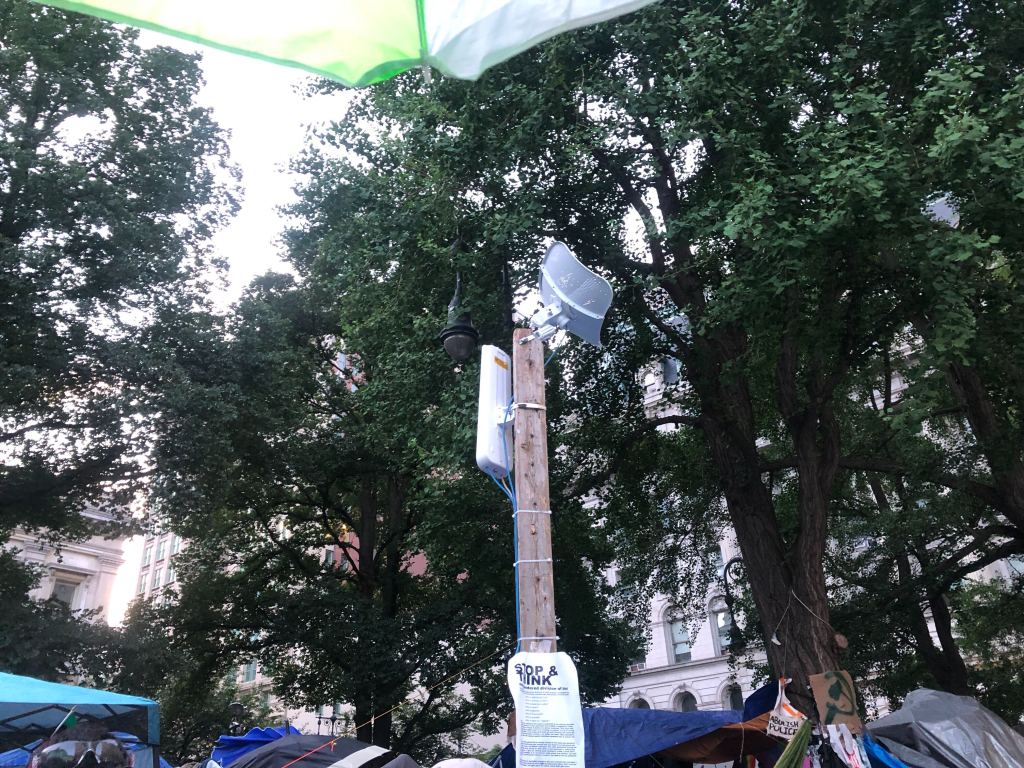For two consecutive nights, protesters sleeping in Manhattan’s City Hall Park awoke to the sounds of megaphones as large crowds of riot cops descended on their encampment—an autonomous hub created amidst the ongoing protests against police violence and systemic racism.
Over the past week, the protesters have turned the encampment into a living demonstration of a world without police, with hundreds of volunteers serving free food, picking up trash, and distributing hand sanitizer and other supplies. In this same spirit of mutual aid, volunteers with NYC Mesh have created free Wi-Fi access points for the park’s residents, establishing a network that accesses the internet without relying on traditional Internet Service Providers (ISP).
Videos by VICE
The project started last week, when NYC Mesh volunteers set up routing equipment and a directional antenna in the center of the park. According to NYC Mesh, the antenna beams data between the park and another antenna set up on the municipal building across the street, in a window outside the offices of Manhattan Borough President Gale Brewer. It is then connected via a point-to-point 60 GHz beam aimed at the towering nearby datacenter at 375 Pearl Street, a former Verizon building which contains the Internet Exchange Point (IXP) that connects to the wider internet.

While the network isn’t technically an ad-hoc mesh network, like the kind that NYC Mesh normally uses to provide free access to underserved communities across the city, the volunteers say it’s their contribution to the wider cause of defunding the NYPD.
“This is a great example of how a community network infrastructure can be activated quickly for a political use that is relevant and important,” said Vladimir Vince, a volunteer with NYC Mesh who helped create the park’s internet setup. “You could not do this with a commercial network.”
The activity at the encampment has been supported by a constant influx of volunteers, who have sustained protesters with food and resources as they demand the defunding of the NYPD and a reinvestment in underfunded schools, healthcare, food assistance programs, and more. Late Tuesday night, the city council passed a budget that Mayor Bill De Blasio claimed would defund the police. But the finalized budget does not meet the protesters’ demand of reducing the NYPD’s $6 billion budget by at least $1 billion, and in many cases merely reallocates police funds by channeling them through different departments.

A While internet access ranks relatively low among the encampment’s list of needs, the NYC Mesh volunteers say they wanted to contribute what they could to the larger movement. It isn’t the first time internet activists have used their skills to aid a protest movement: In 2012, volunteers at Occupy Wall Street set up a free Wi-Fi network at Zuccotti Park during the months-long occupation protesting corporate greed. Since then, activists have founded organizations like NYC Mesh to set up free community networks that eschew big telecom companies like Verizon and Comcast, which are known for throttling internet speeds and charging progressively higher prices while often refusing to provide service to communities that need it most.
For the members of NYC Mesh, their Wi-Fi network is just another facet of the various volunteer efforts supplying the City Hall encampment with food, clothing, shelter, and other needs as the occupiers continue to hold the space and clash with police. And by providing internet without relying on Internet Service Providers, the project serves as another example of how volunteer efforts can provide services to communities that are often underserved or forgotten by governments and institutions.
“I think what’s really radical about this space is we’re building a small version of the world we want to have,” said Robert Johnson, another member of NYC Mesh who has been on-site at the occupation. “We’re trying to make this a real, usable space, and this is just another element of that.”
More
From VICE
-

Screenshot: Steam -

Photo: Ryan Young / Cornell University -

Photo: Eetum / Getty Images -

Photo: Lajst / Getty Images
